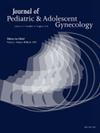15. 儿童和青少年妇科门诊性别认同调查:患者、家庭和提供者的视角(反思性研究)
IF 1.8
4区 医学
Q3 OBSTETRICS & GYNECOLOGY
引用次数: 0
摘要
背景:提供医疗和社会心理支持需要在卫生保健环境中识别性别不同的个人。然而,在初级保健机构中,一些青少年和家长表示,性别认同筛查(GIS)是冒犯性的,临床医生表示,GIS对他们的工作流程产生了负面影响。我们试图评估GIS在美国中西部一家大型三级儿童医院的儿科和青少年妇科(PAG)诊所的可接受性和可行性。方法经许可,对美国西海岸的一项GIS调查进行了修改。经IRB批准后,这项匿名单点横断面调查于2024年7月至9月在PAG诊所对12-25岁的患者(AYA)、12- 17岁的父母和医疗保健提供者(HCPs)进行。统计分析采用SPSS version 29 (IBM Corp, Armonk, NY)。分类变量的比较酌情采用卡方检验/ fisher精确检验或Kruskal-Wallis检验。连续变量比较采用方差分析检验。统计学意义定义为P <; 0.05。结果56名参与者完成了调查(表1)。大多数是12- 17岁的青少年(27人,48.2%)和他们的父母(16人,28.6%)。12- 17岁、18- 25岁、12- 17岁的父母和卫生保健提供者的平均(SD)年龄分别为14.9(1.6)岁、18.4(0.79)岁、46.8(15.4)岁和46.8(15.4)岁。大多数AYA没有发现GIS令人困惑、不舒服或令人反感(表2)。在为孩子进行GIS筛查之前,同样数量的父母希望/不希望得到父母的许可。虽然与HCPs相比,更多的家长倾向于在询问AYA之前告知家长GIS的内容,但差异不显著(10,62.5% vs. 2,33.3%, p=.348)。大多数18- 25岁的人(4,57.1%)、12- 17岁的父母(12,75%)和HCPs(6,100%)认为不应该在父母面前进行GIS,而12- 17岁的人中只有9人(33.3%)认为不应该在父母面前进行GIS (p= 0.005)。与大多数喜欢在电脑或平板电脑上输入GIS的18- 25岁的患者(5,71.4%)相比,16名(80%)12- 17岁的患者和6名(100%)HCPs更喜欢患者和提供者之间直接沟通的GIS首选方法之间存在统计学上的显著差异(p= 0.008)。HCPs不认为GIS会影响他们的工作流程。结论在PAG临床中,患者对GIS方法有不同的偏好,应引起临床医生的重视。本文章由计算机程序翻译,如有差异,请以英文原文为准。
15. Asking About Gender Identity in Pediatric and Adolescent Gynecology Clinic: Patient, Family and Provider Perspectives (The REFLECTIVE Study).
Background
The provision of medical and psychosocial supports requires the identification of gender diverse individuals in health care settings. However, in primary care settings, some adolescents and parents expressed that gender identity screening (GIS) was offensive and clinicians expressed that GIS negatively affected their workflow. We sought to assess the acceptability and feasibility of GIS in Pediatric and Adolescent Gynecology (PAG) clinics of a large tertiary care children's hospital in the United States (US) Midwest.
Methods
A GIS survey developed in the US West Coast was modified with permission. After IRB approval, the anonymous single-site cross-sectional survey was administered to patients ages 12-25 years (AYA), parents of the 12-to-17-year-olds, and healthcare providers (HCPs) in our PAG clinics from July through September 2024. Statistical analysis was performed using SPSS version 29 (IBM Corp, Armonk, NY). Categorical variables were compared using the Chi-Square test /Fishers’ exact test or the Kruskal-Wallis test as appropriate. Continuous variables were compared using the ANOVA test. Statistical significance was defined as P <.05.
Results
Fifty-six participants completed the survey (Table1). The majority were 12-to17-year-olds (27, 48.2%) and their parents (16, 28.6%). The mean (SD) age of 12-to-17-year-olds, 18-to-25-years-olds, parents of 12-to-17-year-olds, and healthcare providers (HCPs) was 14.9 (1.6), 18.4 (.79), 46.8 (15.4), and 46.8 (15.4) years, respectively. Most AYA did not find GIS confusing, uncomfortable, or offensive (Table 2). An equal number of parents did/did not want parental permission prior to GIS screening for their children. Although more parents than HCPs preferred informing parents about the content of GIS before AYA were asked questions, the difference was not significant (10, 62.5% vs. 2, 33.3%, p=.348). Most 18-to-25-years-olds (4, 57.1%), parents of 12-to-17-year-olds (12, 75%), and HCPs (6, 100%) did not think that GIS should be performed in front of parents as compared to only 9 (33.3%) of 12-to-17-year-olds (p=.005). There was a statistically significant difference between the preferred method of GIS with 16 (80%) of 12-to-17-year-olds and 6 (100%) of HCPs preferring direct communication between patient and provider as compared to most 18-to-25-years-olds (5, 71.4%) who preferred to enter GIS on a computer or tablet (p=.008). HCPs did not think that GIS affected their workflow.
Conclusions
AYA have differing preferences for the method of GIS in PAG clinics which HCPs should take into consideration.
求助全文
通过发布文献求助,成功后即可免费获取论文全文。
去求助
来源期刊
CiteScore
3.90
自引率
11.10%
发文量
251
审稿时长
57 days
期刊介绍:
Journal of Pediatric and Adolescent Gynecology includes all aspects of clinical and basic science research in pediatric and adolescent gynecology. The Journal draws on expertise from a variety of disciplines including pediatrics, obstetrics and gynecology, reproduction and gynecology, reproductive and pediatric endocrinology, genetics, and molecular biology.
The Journal of Pediatric and Adolescent Gynecology features original studies, review articles, book and literature reviews, letters to the editor, and communications in brief. It is an essential resource for the libraries of OB/GYN specialists, as well as pediatricians and primary care physicians.

 求助内容:
求助内容: 应助结果提醒方式:
应助结果提醒方式:


